Investigation into the Genomic History of Grapevine
The history of cultivated grapevine (Vitis vinifera ssp. vinifera) is closely tied to human history and development leading to great diversity in this food source and wine ingredient. The connection to culture in many Eurasian countries has given grapevine a position of importance and led to significant research into its history, from its wild ancestor (Vitis vinifera ssp. Sylvestris ssp. sylvestris) through domestication events leading to modern grape varieties. However, genetic data has been insufficient in scope to reconstruct a robust ancestry. To get more accurate results, Dong and colleagues sequenced and assembled a Vv. sylvestris genome (VS-1) to anchor genetic variation from a more comprehensive global sample set of 3525 cultivated and wild accessions. They used an unsupervised admixture analysis and hierarchical clustering to pinpoint four Vv. sylvestris groupings (Western Asia, the Caucasus, Central Europe, the Iberian peninsula) associated with specific geographic locations. The Western Asia and Caucasus accessions were grouped together as the eastern ecotype and the Central Europe and Iberian peninsula accessions were labeled the western ecotype. Nucleotide diversity and individual heterozygosity as well as linkage disequilibrium decay indicate significantly more genetic diversity in the eastern ecotype. Results from folded SNP frequency spectra indicated that the two ecotypes split from each other 200,000-400,000 years ago during the Pleistocene period.
Cultivated grapes can be broken down into six distinct genetic ancestries (CG1-CG6) and the fact that CG1 (table grapevine varieties) and CG2 (wine grapevine varieties) share ancestry with Western Asian and Caucasus wild type accessions respectively indicates dual domestication events. CG3-CG6 emerged following a pair of introgression events in the neolithic period (approximately 10,000 and 6,900 years ago). In their comparison of the domestication signatures of CG1 and CG2, Dong and collaborators selected regions of genes that showed greater nucleotide diversity differences and “population differentiation”. They confirmed that for both CG1 and CG2 the traits, flower sexual morphs, berry skin color and berry development were important, and selected for during domestication. In addition, they found that genes for grapevine growth, physiology, fruit set, and biotic and abiotic stress resistance were common to both groups. CG1 and CG2 also both had domestication genes which sought similar results in different ways; for example, both had genes selected for improvement of perceived berry desirability with the BEAT gene for floral scent being selected for in CG1 while the UFGT gene for berry color was selected for in CG2. The researchers hypothesize that the initial purpose of domesticating both CG1 and CG2 may have been for human consumption, and the features conducive to wine-making may have developed by chance, afterwards. The ten shared genetic regions among CG3-CG6 are associated with plant immunity, abiotic stress response, and carbohydrate metabolism, and are advantageous for adapting to the European environment and winemaking. The authors also analyzed specific traits (berry palatability, hermaphroditism, muscat flavor, and berry skin color) and found that they show selection events associated with early Eurasian agriculture. This study demonstrates the power of harnessing the genetic diversity of a crop to trace its domestication history.
Gramene examples:
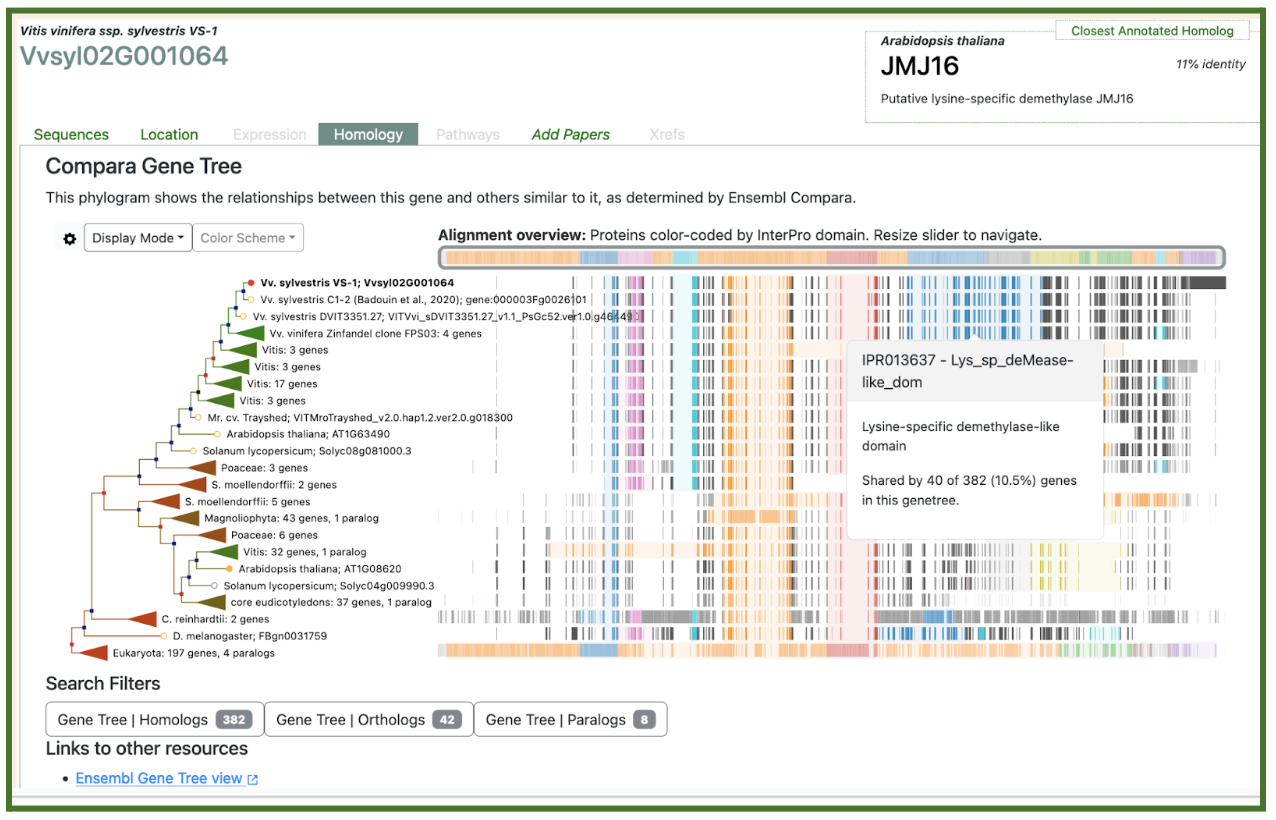
Figure 1: The putative lysine-specific demethylase Vvsyl02G001064 gene is featured in this paper because of its association with berry skin color. The default view when searching for this gene in the Gramene Vitis pangenome site is its phylogenetic tree with color coded protein domains. Users should click on a colored box to learn more about the domain, as shown in the inset for the large blue box that demarcates a lysine-specific demethylase-like domain.
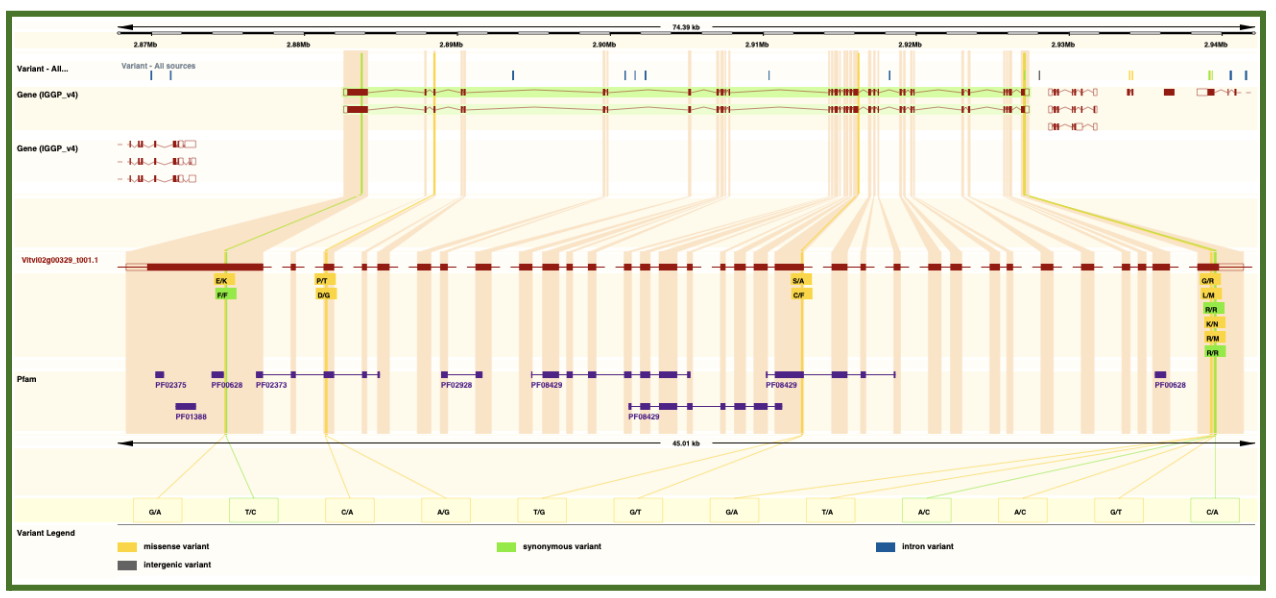
Figure 2: The genetic variation image view of a Vvsyl02G001064 gene transcript showing SNP variants color coded by predicted functional effect in the protein lined up with the gene’s protein domains.
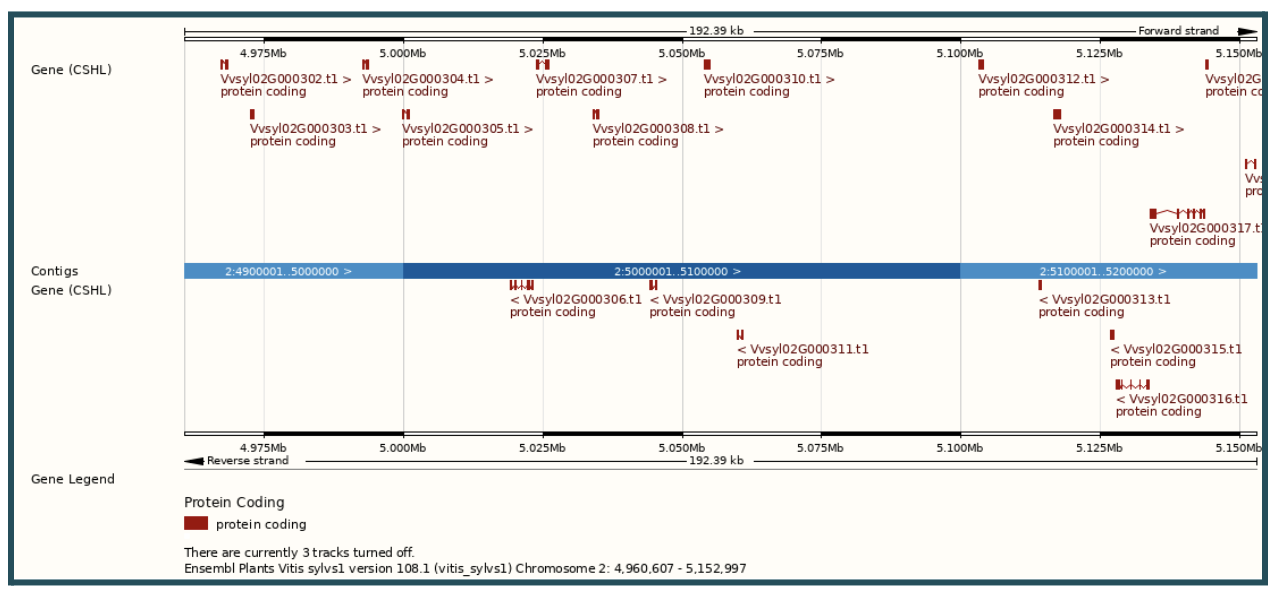
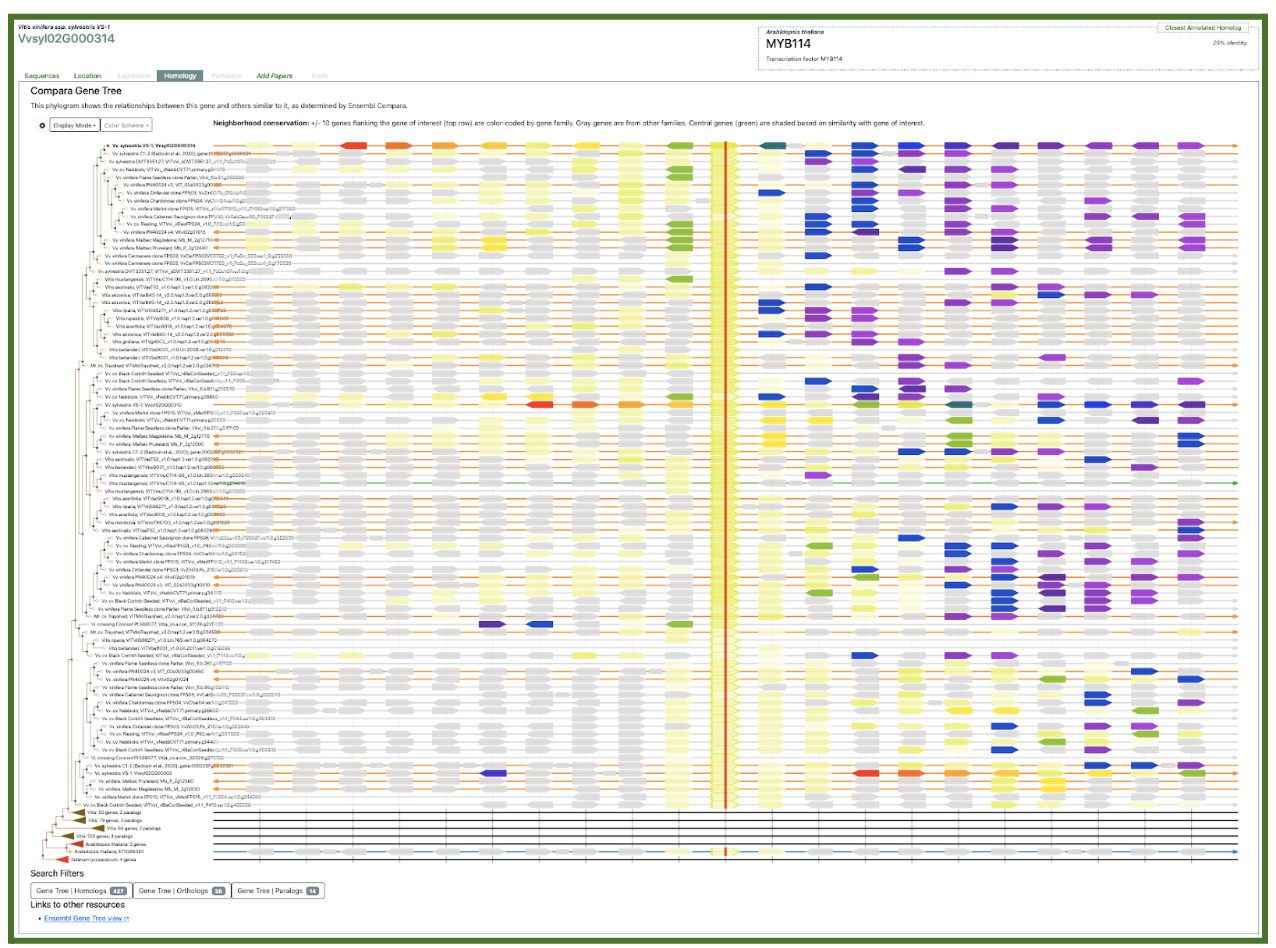
Figure 3: The gene tree for the VvMybA genes with SNPs associated with berry pigmentation reveals a total of 14 grapevine paralogs, 8 of which (Vvsyl02G000302, Vvsyl02G000303, Vvsyl02G000304, Vvsyl02G000305, Vvsyl02G000310, Vvsyl02G000312, Vvsyl02G000314 and Vvsyl02G000317) map to the VvMybA locus (see for example, paralogs for Vvsyl02G000314 in the Gramene Vitis Search or the Gramene Vitis Ensembl browser). The gene neighborhood view for Vvsyl02G000314 shows a high degree of conservation across the gene cluster (for reference, Vvsyl02G000303/VvMybA3, Vvsyl02G000310/VvMybA1 and Vvsyl02G000314/VvMybA2 can be easily identified following the red/orange genes between Vvsyl02G000303 and Vvsyl02G000310). This view shows 10 genes flanking each side of a gene in the same tree.
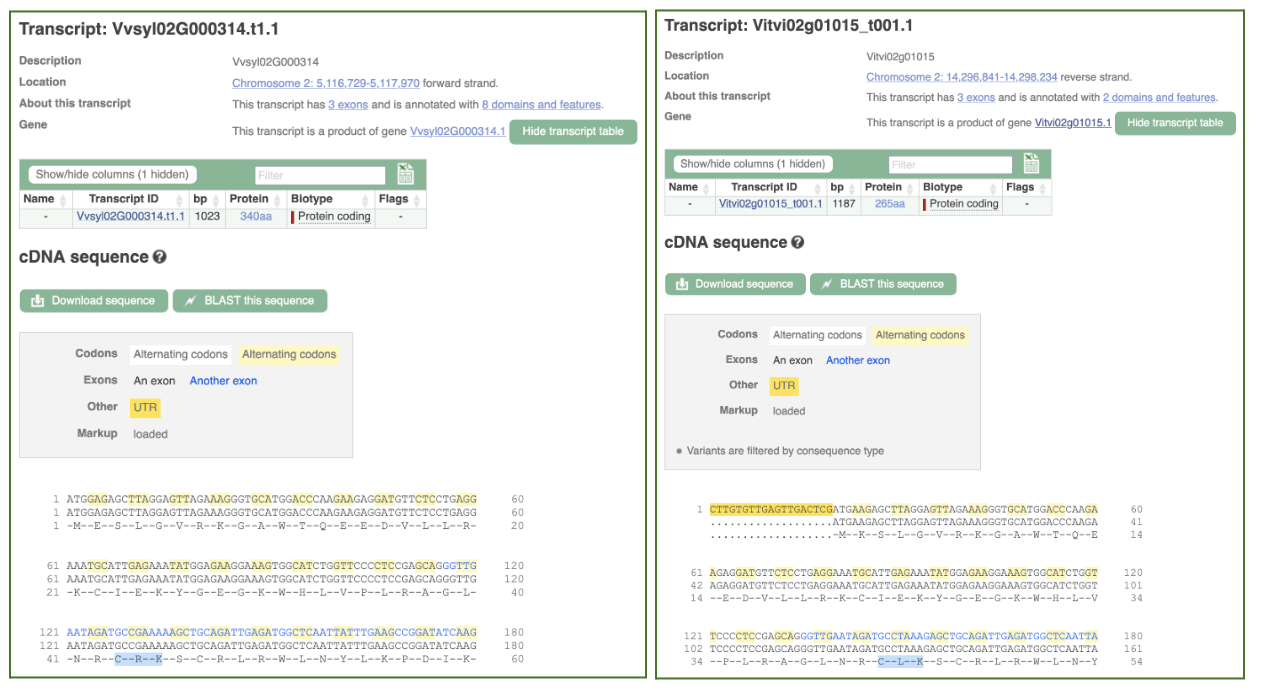
Figure 4: A comparison of the cDNA of Vvsyl02G000314 and its V. vinifera PN40024 ortholog Vitvi02g01015, shows that the sylvestris gene has the G allele at position 2:5,116,947 which encodes an Arginine (R), the domesticated reference has a T allele encoding a Leucine (L) at the corresponding position, further confirming the existence of a multiallelic SNP at this position.
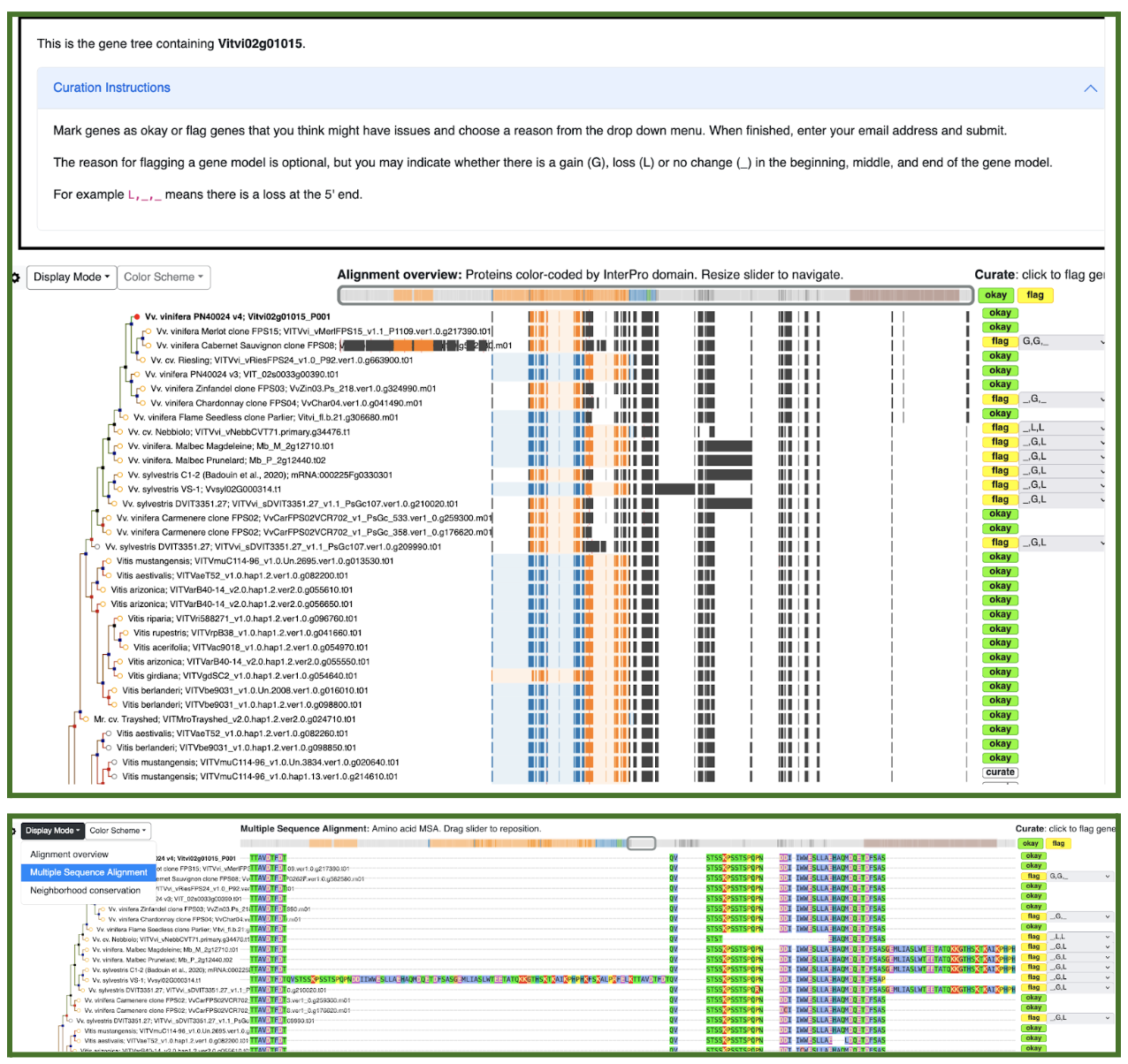
Figure 5: The Gramene’s Gene Tree Curation Tool allowed us to flag the Vvsyl02G000314 gene model as well as several others for further structural curation due to stretches of amino acids not conserved in other grapevine strains nor Arabidopsis (see multiple alignment detailed view).
Reference:
Dong Y, Duan S, Xia Q, Liang Z, Dong X, Margaryan K, Musayev M, Goryslavets S, Zdunić G, Bert PF, Lacombe T, Maul E, Nick P, Bitskinashvili K, Bisztray GD, Drori E, De Lorenzis G, Cunha J, Popescu CF, Arroyo-Garcia R, Arnold C, Ergül A, Zhu Y, Ma C, Wang S, Liu S, Tang L, Wang C, Li D, Pan Y, Li J, Yang L, Li X, Xiang G, Yang Z, Chen B, Dai Z, Wang Y, Arakelyan A, Kuliyev V, Spotar G, Girollet N, Delrot S, Ollat N, This P, Marchal C, Sarah G, Laucou V, Bacilieri R, Röckel F, Guan P, Jung A, Riemann M, Ujmajuridze L, Zakalashvili T, Maghradze D, Höhn M, Jahnke G, Kiss E, Deák T, Rahimi O, Hübner S, Grassi F, Mercati F, Sunseri F, Eiras-Dias J, Dumitru AM, Carrasco D, Rodriguez-Izquierdo A, Muñoz G, Uysal T, Özer C, Kazan K, Xu M, Wang Y, Zhu S, Lu J, Zhao M, Wang L, Jiu S, Zhang Y, Sun L, Yang H, Weiss E, Wang S, Zhu Y, Li S, Sheng J, Chen W. Dual domestications and origin of traits in grapevine evolution. Science. 2023 Mar 3;379(6635):892-901. PMID: 36862793. DOI: 10.1126/science.add8655.
- aolson's blog
- Log in to post comments
